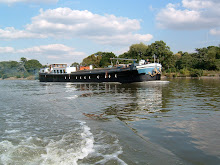We had planned to leave Cambrai today but became side-tracked. On a brief outing in the car we managed to spend a small fortune in an amazing supermarket and visit a museum dedicated to the Canal St Quentin which we were about to explore with Lobelia.
(Warning : history lesson now follows. Skip to Friday if you don’t fancy it.)
The canal, which runs 92km from Cambrai to Chauny and combines the Escaut and Somme rivers, is celebrating its 200th anniversary this year. And it has been an extremely eventful 200 years. The canal’s crown is the Riqueval tunnel which was commissioned by Napoleon. Two tunnels were built by 3000 war prisoners over a period of eight years. The first is 5.7km long and the second is 1.1km. In 1810 Napoleon cut the ribbon and, accompanied by a retinue of guards he ceremoniously rode through the tunnels on horseback. Unfortunately Napoleon’s horse rode into a ladder and Napoleon, who thought he was in danger of being assassinated, charged through the rest of the tunnels with his retinue in hot pursuit. That was probably the last thing to ever go through the tunnels at speed.
When the tunnel was ready to receive its first barge, all the local boatmen were fearful to enter it until it had been proven to be safe. A decision was made to give freedom from tolls in perpetuity to the first vessel through the tunnels. The race to be the first boat must have been spectacular! Apparently the winning boat, built of timber, is said to have remained in service well in excess of a century and the hull replaced several times during its extraordinarily long working life. For fellow fans of Only Fools and Horses this sounds remarkably like a case of Trigger’s broom!
Fume build-up in the tunnels meant that boats were not allowed to go through the tunnels under their own power. They had to be towed. At the beginning, gangs of 8 men would haul through barges by hand on a journey that took more than 12 hours. In 1863 they were replaced by a carousel of horses whose circular movement drove gears connected to a submerged chain. And then the “touer” took over. And it is still in use today. A bizarre looking electric tug which connects to electric wires overhead and pulls itself and its customers along by the submerged chain. The procedure was slow, dark and noisy. The record for number of boats pulled said to be 74. Up until the mid 1960s the canal was the main commercial route and hundreds of barges like ours used the canal every day. Today it is mostly used by tourists.

During World War 1 both tunnels were used by the Germans as defences in the Hindenburg Line. Shafts were dug to connect the tunnels with other fortifications. The tunnels, which were impregnable fortifications, were fitted with electric lighting for the first time and were used as stabling, hospitals and command centres. When British troops finally broke the line they posed for a remarkable photograph at the entrance to the tunnel at Riqueval. (sorry but have struggled to upload the photo. You can see it online via Imperial War Museum archive)








































